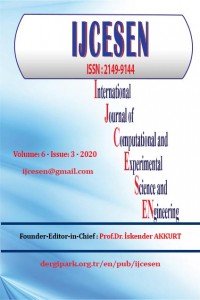Öz
Kaynakça
- Referans1 H. Duan, D. Wang and Y. Li, Green chemistry for nanoparticle synthesis, Chem. Soc. Rev., 44(16): 5778—5792. DOI: 10.1039/c4cs00363b, 2015. Referans2 J. Virkutyte and R.S. Varma, Green synthesis of metal nanoparticles: Biodegradable polymers and enzymes in stabilization and surface functionalization, Chem. Sci., 2(5): 837–846, DOI: 10.1039/c0sc00338g, 2011. Referans3 W.J. Stark, P.R. Stoessel, W. Wohlleben and A. Hafner, Industrial applications of nanoparticles, Chem. Soc. Rev., 44, 5793-5805, DOI:10.1039/C4CS00362D, 2015. Referans4 J. Zhao, Y. Mi, K. Wang, Y. Ma and J. Yang, Fluorescence Magnetic Particle Flaw Detecting System Based on Low Light Level CCD., Int. 16th World Conference NDT Proceeding, pp 1–7, 2004. Referans5 The American Society for Nondestructive Testing, (access time: 20 Sep. 2019) https://www.asnt.org/MinorSiteSections/AboutASNT/Intro-to-NDT. Referans6 M.F. Heba, M.M. Fatma, M.H. Marzouq, A.B. Mustafa, A.M. Alsoudi, O.A. Ali, M. Mohamed, F.A. Mahmoud, Review of Green Methods of Iron Nanoparticles Synthesis and Applications, BioNanoScience, 8.2: 491-503, DOI: 10.1007/s12668-018-0516-5, 2018. Referans7 NDT Supply; (access time: 25 Sep. 2019), https://ndtsupply.com/magnaflux-7-magnetic-particle-test-bar.html.
Magnetic Nanoparticles Synthesized By Green Chemistry and Investigation of Its Application in the Material Industry
Öz
In the past decade, the use of plants for synthesis of nanoparticles have been intensively studied. Various plants have been employed to synthesis nanomaterials in all fields of science and industry. Particularly, Magnetic nanoparticles (MNPs) are emerging as new subject of research for their application in different fields of industry. Conventional techniques for nanoparticles synthesis require hazardous chemicals that have many risks due to their toxicity and serious concerns for environment and health. On the other hand, plant-mediated synthesis of nanoparticles seems to be have an effective way in developing inexpensive, nontoxic and eco-friendly materials.
The aim of this study is to examine the use of iron magnetic nanoparticles synthesized by green chemistry as a liquid penetrant for investigating potential of detection micro surface flaws on industrial materials. For this purpose, green tea extract (GTE) were used as a reduction agent for synthesis of iron (Fe3O4) nanoparticles. GTE has high concentration phenolic and carbonyl groups of polyphenol compounds can be responsible for the formation Fe3O4 nanoparticles. The synthesized nanoparticles (Fe3O4-GTE NPs) was characterized by X-ray Photoelectron Spectroscopy (XPS), Fourier-transform Infrared Spectroscopy (FTIR), Dynamic Light Scattering (DLS) and Vibrating-Sample Magnetometer (VSM). Their sizes are mostly around 1200-2200 nm. The experimental results showed that plant-mediated iron nanoparticles has great potential as a new penetrant for Fluorescent penetrant inspection (FPI) applications.
Anahtar Kelimeler
Kaynakça
- Referans1 H. Duan, D. Wang and Y. Li, Green chemistry for nanoparticle synthesis, Chem. Soc. Rev., 44(16): 5778—5792. DOI: 10.1039/c4cs00363b, 2015. Referans2 J. Virkutyte and R.S. Varma, Green synthesis of metal nanoparticles: Biodegradable polymers and enzymes in stabilization and surface functionalization, Chem. Sci., 2(5): 837–846, DOI: 10.1039/c0sc00338g, 2011. Referans3 W.J. Stark, P.R. Stoessel, W. Wohlleben and A. Hafner, Industrial applications of nanoparticles, Chem. Soc. Rev., 44, 5793-5805, DOI:10.1039/C4CS00362D, 2015. Referans4 J. Zhao, Y. Mi, K. Wang, Y. Ma and J. Yang, Fluorescence Magnetic Particle Flaw Detecting System Based on Low Light Level CCD., Int. 16th World Conference NDT Proceeding, pp 1–7, 2004. Referans5 The American Society for Nondestructive Testing, (access time: 20 Sep. 2019) https://www.asnt.org/MinorSiteSections/AboutASNT/Intro-to-NDT. Referans6 M.F. Heba, M.M. Fatma, M.H. Marzouq, A.B. Mustafa, A.M. Alsoudi, O.A. Ali, M. Mohamed, F.A. Mahmoud, Review of Green Methods of Iron Nanoparticles Synthesis and Applications, BioNanoScience, 8.2: 491-503, DOI: 10.1007/s12668-018-0516-5, 2018. Referans7 NDT Supply; (access time: 25 Sep. 2019), https://ndtsupply.com/magnaflux-7-magnetic-particle-test-bar.html.
Ayrıntılar
| Birincil Dil | İngilizce |
|---|---|
| Bölüm | Research Articles |
| Yazarlar | |
| Yayımlanma Tarihi | 30 Kasım 2020 |
| Gönderilme Tarihi | 7 Mayıs 2020 |
| Kabul Tarihi | 15 Kasım 2020 |
| Yayımlandığı Sayı | Yıl 2020 Cilt: 6 Sayı: 3 |

